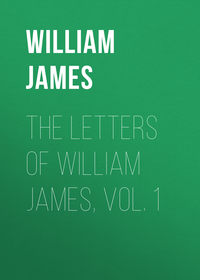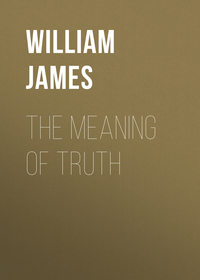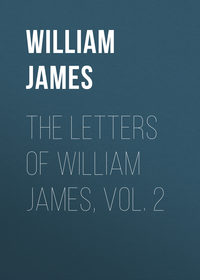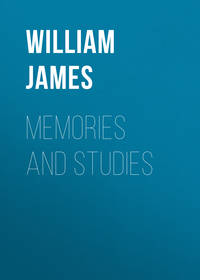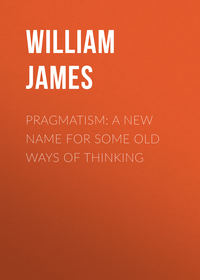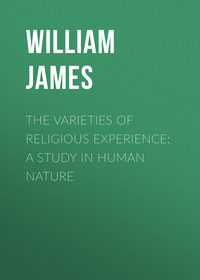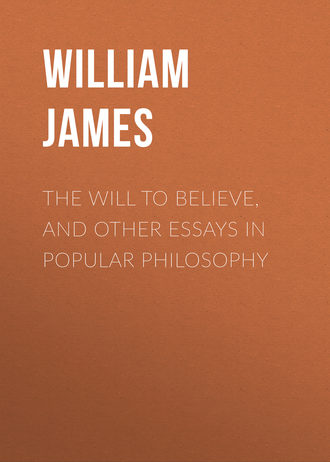 полная версия
полная версияThe Will to Believe, and Other Essays in Popular Philosophy
According to the newspaper and drawing-room myth, soft-headedness and idiotic credulity are the bond of sympathy in this Society, and general wonder-sickness its dynamic principle. A glance at the membership fails, however, to corroborate this view. The president is Prof. Henry Sidgwick,62 known by his other deeds as the most incorrigibly and exasperatingly critical and sceptical mind in England. The hard-headed Arthur Balfour is one vice-president, and the hard-headed Prof. J. P. Langley, secretary of the Smithsonian Institution, is another. Such men as Professor Lodge, the eminent English physicist, and Professor Richet, the eminent French physiologist, are among the most active contributors to the Society's Proceedings; and through the catalogue of membership are sprinkled names honored throughout the world for their scientific capacity. In fact, were I asked to point to a scientific journal where hard-headedness and never-sleeping suspicion of sources of error might be seen in their full bloom, I think I should have to fall back on the Proceedings of the Society for Psychical Research. The common run of papers, say on physiological subjects, which one finds in other professional organs, are apt to show a far lower level of critical consciousness. Indeed, the rigorous canons of evidence applied a few years ago to testimony in the case of certain 'mediums' led to the secession from the Society of a number of spiritualists. Messrs. Stainton Moses and A. R. Wallace, among others, thought that no experiences based on mere eyesight could ever have a chance to be admitted as true, if such an impossibly exacting standard of proof were insisted on in every case.
The S. P. R., as I shall call it for convenience, was founded in 1882 by a number of gentlemen, foremost among whom seem to have been Professors Sidgwick, W. F. Barrett, and Balfour Stewart, and Messrs. R. H. Hutton, Hensleigh Wedgwood, Edmund Gurney, and F. W. H. Myers. Their purpose was twofold,—first, to carry on systematic experimentation with hypnotic subjects, mediums, clairvoyants, and others; and, secondly, to collect evidence concerning apparitions, haunted houses, and similar phenomena which are incidentally reported, but which, from their fugitive character, admit of no deliberate control. Professor Sidgwick, in his introductory address, insisted that the divided state of public opinion on all these matters was a scandal to science,—absolute disdain on à priori grounds characterizing what may be called professional opinion, while indiscriminate credulity was too often found among those who pretended to have a first-hand acquaintance with the facts.
As a sort of weather bureau for accumulating reports of such meteoric phenomena as apparitions, the S. P. R. has done an immense amount of work. As an experimenting body, it cannot be said to have completely fulfilled the hopes of its founders. The reasons for this lie in two circumstances: first, the clairvoyant and other subjects who will allow themselves to be experimented upon are few and far between; and, secondly, work with them takes an immense amount of time, and has had to be carried on at odd intervals by members engaged in other pursuits. The Society has not yet been rich enough to control the undivided services of skilled experimenters in this difficult field. The loss of the lamented Edmund Gurney, who more than any one else had leisure to devote, has been so far irreparable. But were there no experimental work at all, and were the S. P. R. nothing but a weather-bureau for catching sporadic apparitions, etc., in their freshness, I am disposed to think its function indispensable in the scientific organism. If any one of my readers, spurred by the thought that so much smoke must needs betoken fire, has ever looked into the existing literature of the supernatural for proof, he will know what I mean. This literature is enormous, but it is practically worthless for evidential purposes. Facts enough are cited, indeed; but the records of them are so fallible and imperfect that at most they lead to the opinion that it may be well to keep a window open upon that quarter in one's mind.
In the S. P. R.'s Proceedings, on the contrary, a different law prevails. Quality, and not mere quantity, is what has been mainly kept in mind. The witnesses, where possible, have in every reported case been cross-examined personally, the collateral facts have been looked up, and the story appears with its precise coefficient of evidential worth stamped on it, so that all may know just what its weight as proof may be. Outside of these Proceedings, I know of no systematic attempt to weigh the evidence for the supernatural. This makes the value of the volumes already published unique; and I firmly believe that as the years go on and the ground covered grows still wider, the Proceedings will more and more tend to supersede all other sources of information concerning phenomena traditionally deemed occult. Collections of this sort are usually best appreciated by the rising generation. The young anthropologists and psychologists who will soon have full occupancy of the stage will feel how great a scientific scandal it has been to leave a great mass of human experience to take its chances between vague tradition and credulity on the one hand and dogmatic denial at long range on the other, with no body of persons extant who are willing and competent to study the matter with both patience and rigor. If the Society lives long enough for the public to become familiar with its presence, so that any apparition, or house or person infested with unaccountable noises or disturbances of material objects, will as a matter of course be reported to its officers, we shall doubtless end by having a mass of facts concrete enough to theorize upon. Its sustainers, therefore, should accustom themselves to the idea that its first duty is simply to exist from year to year and perform this recording function well, though no conclusive results of any sort emerge at first. All our learned societies have begun in some such modest way.
But one cannot by mere outward organization make much progress in matters scientific. Societies can back men of genius, but can never take their place. The contrast between the parent Society and the American Branch illustrates this. In England, a little group of men with enthusiasm and genius for the work supplied the nucleus; in this country, Mr. Hodgson had to be imported from Europe before any tangible progress was made. What perhaps more than anything else has held the Society together in England is Professor Sidgwick's extraordinary gift of inspiring confidence in diverse sorts of people. Such tenacity of interest in the result and such absolute impartiality in discussing the evidence are not once in a century found in an individual. His obstinate belief that there is something yet to be brought to light communicates patience to the discouraged; his constitutional inability to draw any precipitate conclusion reassures those who are afraid of being dupes. Mrs. Sidgwick—a sister, by the way, of the great Arthur Balfour—is a worthy ally of her husband in this matter, showing a similarly rare power of holding her judgment in suspense, and a keenness of observation and capacity for experimenting with human subjects which are rare in either sex.
The worker of the Society, as originally constituted, was Edmund Gurney. Gurney was a man of the rarest sympathies and gifts. Although, like Carlyle, he used to groan under the burden of his labors, he yet exhibited a colossal power of dispatching business and getting through drudgery of the most repulsive kind. His two thick volumes on 'Phantasms of the Living,' collected and published in three years, are a proof of this. Besides this, he had exquisite artistic instincts, and his massive volume on 'The Power of Sound' was, when it appeared, the most important work on aesthetics in the English language. He had also the tenderest heart and a mind of rare metaphysical power, as his volumes of essays, 'Tertium Quid,' will prove to any reader. Mr. Frederic Myers, already well known as one of the most brilliant of English essayists, is the ingenium praefervidum of the S. P. R. Of the value of Mr. Myers's theoretic writings I will say a word later. Dr. Hodgson, the American secretary, is distinguished by a balance of mind almost as rare in its way as Sidgwick's. He is persuaded of the reality of many of the phenomena called spiritualistic, but he also has uncommon keenness in detecting error; and it is impossible to say in advance whether it will give him more satisfaction to confirm or to smash a given case offered to his examination.
It is now time to cast a brief look upon the actual contents of these Proceedings. The first two years were largely taken up with experiments in thought-transference. The earliest lot of these were made with the daughters of a clergyman named Creery, and convinced Messrs. Balfour Stewart, Barrett, Myers, and Gurney that the girls had an inexplicable power of guessing names and objects thought of by other persons. Two years later, Mrs. Sidgwick and Mr. Gurney, recommencing experiments with the same girls, detected them signalling to each other. It is true that for the most part the conditions of the earlier series had excluded signalling, and it is also possible that the cheating may have grafted itself on what was originally a genuine phenomenon. Yet Gurney was wise in abandoning the entire series to the scepticism of the reader. Many critics of the S. P. R. seem out of all its labors to have heard only of this case. But there are experiments recorded with upwards of thirty other subjects. Three were experimented upon at great length during the first two years: one was Mr. G. A. Smith; the other two were young ladies in Liverpool in the employment of Mr. Malcolm Guthrie.
It is the opinion of all who took part in these latter experiments that sources of conscious and unconscious deception were sufficiently excluded, and that the large percentage of correct reproductions by the subjects of words, diagrams, and sensations occupying other persons' consciousness were entirely inexplicable as results of chance. The witnesses of these performances were in fact all so satisfied of the genuineness of the phenomena, that 'telepathy' has figured freely in the papers of the Proceedings and in Gurney's book on Phantasms as a vera causa on which additional hypotheses might be built. No mere reader can be blamed, however, if he demand, for so revolutionary a belief, a more overwhelming bulk of testimony than has yet been supplied. Any day, of course, may bring in fresh experiments in successful picture-guessing. But meanwhile, and lacking that, we can only point out that the present data are strengthened in the flank, so to speak, by all observations that tend to corroborate the possibility of other kindred phenomena, such as telepathic impression, clairvoyance, or what is called 'test-mediumship.' The wider genus will naturally cover the narrower species with its credit.
Gurney's papers on hypnotism must be mentioned next. Some of them are less concerned with establishing new facts than with analyzing old ones. But omitting these, we find that in the line of pure observation Gurney claims to have ascertained in more than one subject the following phenomenon: The subject's hands are thrust through a blanket, which screens the operator from his eyes, and his mind is absorbed in conversation with a third person. The operator meanwhile points with his finger to one of the fingers of the subject, which finger alone responds to this silent selection by becoming stiff or anaesthetic, as the case may be. The interpretation is difficult, but the phenomenon, which I have myself witnessed, seems authentic.
Another observation made by Gurney seems to prove the possibility of the subject's mind being directly influenced by the operator's. The hypnotized subject responds, or fails to respond, to questions asked by a third party according to the operator's silent permission or refusal. Of course, in these experiments all obvious sources of deception were excluded. But Gurney's most important contribution to our knowledge of hypnotism was his series of experiments on the automatic writing of subjects who had received post-hypnotic suggestions. For example, a subject during trance is told that he will poke the fire in six minutes after waking. On being waked he has no memory of the order, but while he is engaged in conversation his hand is placed on a planchette, which immediately writes the sentence, "P., you will poke the fire in six minutes." Experiments like this, which were repeated in great variety, seem to prove that below the upper consciousness the hypnotic consciousness persists, engrossed with the suggestion and able to express itself through the involuntarily moving hand.
Gurney shares, therefore, with Janet and Binet, the credit of demonstrating the simultaneous existence of two different strata of consciousness, ignorant of each other, in the same person. The 'extra-consciousness,' as one may call it, can be kept on tap, as it were, by the method of automatic writing. This discovery marks a new era in experimental psychology, and it is impossible to overrate its importance. But Gurney's greatest piece of work is his laborious 'Phantasms of the Living.' As an example of the drudgery stowed away in the volumes, it may suffice to say that in looking up the proofs for the alleged physical phenomena of witchcraft, Gurney reports a careful search through two hundred and sixty books on the subject, with the result of finding no first-hand evidence recorded in the trials except the confessions of the victims themselves; and these, of course, are presumptively due to either torture or hallucination. This statement, made in an unobtrusive note, is only one instance of the care displayed throughout the volumes. In the course of these, Gurney discusses about seven hundred cases of apparitions which he collected. A large number of these were 'veridical,' in the sense of coinciding with some calamity happening to the person who appeared. Gurney's explanation is that the mind of the person undergoing the calamity was at that moment able to impress the mind of the percipient with an hallucination.
Apparitions, on this 'telepathic' theory, may be called 'objective' facts, although they are not 'material' facts. In order to test the likelihood of such veridical hallucinations being due to mere chance, Gurney instituted the 'census of hallucinations,' which has been continued with the result of obtaining answers from over twenty-five thousand persons, asked at random in different countries whether, when in good health and awake, they had ever heard a voice, seen a form, or felt a touch which no material presence could account for. The result seems to be, roughly speaking, that in England about one adult in ten has had such an experience at least once in his life, and that of the experiences themselves a large number coincide with some distant event. The question is, Is the frequency of these latter cases too great to be deemed fortuitous, and must we suppose an occult connection between the two events? Mr. and Mrs. Sidgwick have worked out this problem on the basis of the English returns, seventeen thousand in number, with a care and thoroughness that leave nothing to be desired. Their conclusion is that the cases where the apparition of a person is seen on the day of his death are four hundred and forty times too numerous to be ascribed to chance. The reasoning employed to calculate this number is simple enough. If there be only a fortuitous connection between the death of an individual and the occurrence of his apparition to some one at a distance, the death is no more likely to fall on the same day as the apparition than it is to occur on the same day with any other event in nature. But the chance-probability that any individual's death will fall on any given day marked in advance by some other event is just equal to the chance-probability that the individual will die at all on any specified day; and the national death-rate gives that probability as one in nineteen thousand. If, then, when the death of a person coincides with an apparition of the same person, the coincidence be merely fortuitous, it ought not to occur oftener than once in nineteen thousand cases. As a matter of fact, however, it does occur (according to the census) once in forty-three cases, a number (as aforesaid) four hundred and forty times too great. The American census, of some seven thousand answers, gives a remarkably similar result. Against this conclusion the only rational answer that I can see is that the data are still too few; that the net was not cast wide enough; and that we need, to get fair averages, far more than twenty-four thousand answers to the census question. This may, of course, be true, though it seems exceedingly unlikely; and in our own twenty-four thousand answers veridical cases may possibly have heaped themselves unduly.
The next topic worth mentioning in the Proceedings is the discussion of the physical phenomena of mediumship (slate-writing, furniture-moving, and so forth) by Mrs. Sidgwick, Mr. Hodgson, and 'Mr. Davey.' This, so far as it goes, is destructive of the claims of all the mediums examined. 'Mr. Davey' himself produced fraudulent slate-writing of the highest order, while Mr. Hodgson, a 'sitter' in his confidence, reviewed the written reports of the series of his other sitters,—all of them intelligent persons,—and showed that in every case they failed to see the essential features of what was done before their eyes. This Davey-Hodgson contribution is probably the most damaging document concerning eye-witnesses' evidence that has ever been produced. Another substantial bit of work based on personal observation is Mr. Hodgson's report on Madame Blavatsky's claims to physical mediumship. This is adverse to the lady's pretensions; and although some of Madame Blavatsky's friends make light of it, it is a stroke from which her reputation will not recover.
Physical mediumship in all its phases has fared hard in the Proceedings. The latest case reported on is that of the famous Eusapia Paladino, who being detected in fraud at Cambridge, after a brilliant career of success on the continent, has, according to the draconian rules of method which govern the Society, been ruled out from a further hearing. The case of Stainton Moses, on the other hand, concerning which Mr. Myers has brought out a mass of unpublished testimony, seems to escape from the universal condemnation, and appears to force upon us what Mr. Andrew Lang calls the choice between a moral and a physical miracle.
In the case of Mrs. Piper, not a physical but a trance medium, we seem to have no choice offered at all. Mr. Hodgson and others have made prolonged study of this lady's trances, and are all convinced that super-normal powers of cognition are displayed therein. These are primâ facie due to 'spirit-control.' But the conditions are so complex that a dogmatic decision either for or against the spirit-hypothesis must as yet be postponed.
One of the most important experimental contributions to the Proceedings is the article of Miss X. on 'Crystal Vision.' Many persons who look fixedly into a crystal or other vaguely luminous surface fall into a kind of daze, and see visions. Miss X. has this susceptibility in a remarkable degree, and is, moreover, an unusually intelligent critic. She reports many visions which can only be described as apparently clairvoyant, and others which beautifully fill a vacant niche incur knowledge of subconscious mental operations. For example, looking into the crystal before breakfast one morning she reads in printed characters of the death of a lady of her acquaintance, the date and other circumstances all duly appearing in type. Startled by this, she looks at the 'Times' of the previous day for verification, and there among the deaths are the identical words which she has seen. On the same page of the Times are other items which she remembers reading the day before; and the only explanation seems to be that her eyes then inattentively observed, so to speak, the death-item, which forthwith fell into a special corner of her memory, and came out as a visual hallucination when the peculiar modification of consciousness induced by the crystal-gazing set in.
Passing from papers based on observation to papers based on narrative, we have a number of ghost stories, etc., sifted by Mrs. Sidgwick and discussed by Messrs. Myers and Podmore. They form the best ghost literature I know of from the point of view of emotional interest. As to the conclusions drawn, Mrs. Sidgwick is rigorously non-committal, while Mr. Myers and Mr. Podmore show themselves respectively hospitable and inhospitable to the notion that such stories have a basis of objectivity dependent on the continued existence of the dead.
I must close my gossip about the Proceedings by naming what, after all, seems to me the most important part of its contents. This is the long series of articles by Mr. Myers on what he now calls the 'subliminal self,' or what one might designate as ultra-marginal consciousness. The result of Myers's learned and ingenious studies in hypnotism, hallucinations, automatic writing, mediumship, and the whole series of allied phenomena is a conviction which he expresses in the following terms:—
"Each of us is in reality an abiding psychical entity far more extensive than he knows,—an individuality which can never express itself completely through any corporeal manifestation. The self manifests itself through the organism; but there is always some part of the self unmanifested, and always, as it seems, some power of organic expression in abeyance or reserve."
The ordinary consciousness Mr. Myers likens to the visible part of the solar spectrum; the total consciousness is like that spectrum prolonged by the inclusion of the ultra-red and ultra-violet rays. In the psychic spectrum the 'ultra' parts may embrace a far wider range, both of physiological and of psychical activity, than is open to our ordinary consciousness and memory. At the lower end we have the physiological extension, mind-cures, 'stigmatization' of ecstatics, etc.; in the upper, the hyper-normal cognitions of the medium-trance. Whatever the judgment of the future may be on Mr. Myers's speculations, the credit will always remain to them of being the first attempt in any language to consider the phenomena of hallucination, hypnotism, automatism, double personality, and mediumship as connected parts of one whole subject. All constructions in this field must be provisional, and it is as something provisional that Mr. Myers offers us his formulations. But, thanks to him, we begin to see for the first time what a vast interlocked and graded system these phenomena, from the rudest motor-automatisms to the most startling sensory-apparition, form. Quite apart from Mr. Myers's conclusions, his methodical treatment of them by classes and series is the first great step toward overcoming the distaste of orthodox science to look at them at all.
One's reaction on hearsay testimony is always determined by one's own experience. Most men who have once convinced themselves, by what seems to them a careful examination, that any one species of the supernatural exists, begin to relax their vigilance as to evidence, and throw the doors of their minds more or less wide open to the supernatural along its whole extent. To a mind that has thus made its salto mortale, the minute work over insignificant cases and quiddling discussion of 'evidential values,' of which the Society's reports are full, seems insufferably tedious. And it is so; few species of literature are more truly dull than reports of phantasms. Taken simply by themselves, as separate facts to stare at, they appear so devoid of meaning and sweep, that, even were they certainly true, one would be tempted to leave them out of one's universe for being so idiotic. Every other sort of fact has some context and continuity with the rest of nature. These alone are contextless and discontinuous.
Hence I think that the sort of loathing—no milder word will do—which the very words 'psychical research' and 'psychical researcher' awaken in so many honest scientific breasts is not only natural, but in a sense praiseworthy. A man who is unable himself to conceive of any orbit for these mental meteors can only suppose that Messrs. Gurney, Myers, & Co.'s mood in dealing with them must be that of silly marvelling at so many detached prodigies. And such prodigies! So science simply falls back on her general non-possumus; and most of the would-be critics of the Proceedings have been contented to oppose to the phenomena recorded the simple presumption that in some way or other the reports must be fallacious,—for so far as the order of nature has been subjected to really scientific scrutiny, it always has been proved to run the other way. But the oftener one is forced to reject an alleged sort of fact by the use of this mere presumption, the weaker does the presumption itself get to be; and one might in course of time use up one's presumptive privileges in this way, even though one started (as our anti-telepathists do) with as good a case as the great induction of psychology that all our knowledge comes by the use of our eyes and ears and other senses. And we must remember also that this undermining of the strength of a presumption by reiterated report of facts to the contrary does not logically require that the facts in question should all be well proved. A lot of rumors in the air against a business man's credit, though they might all be vague, and no one of them amount to proof that he is unsound, would certainly weaken the presumption of his soundness. And all the more would they have this effect if they formed what Gurney called a fagot and not a chain,—that is, if they were independent of one another, and came from different quarters. Now, the evidence for telepathy, weak and strong, taken just as it comes, forms a fagot and not a chain. No one item cites the content of another item as part of its own proof. But taken together the items have a certain general consistency; there is a method in their madness, so to speak. So each of them adds presumptive value to the lot; and cumulatively, as no candid mind can fail to see, they subtract presumptive force from the orthodox belief that there can be nothing in any one's intellect that has not come in through ordinary experiences of sense.




